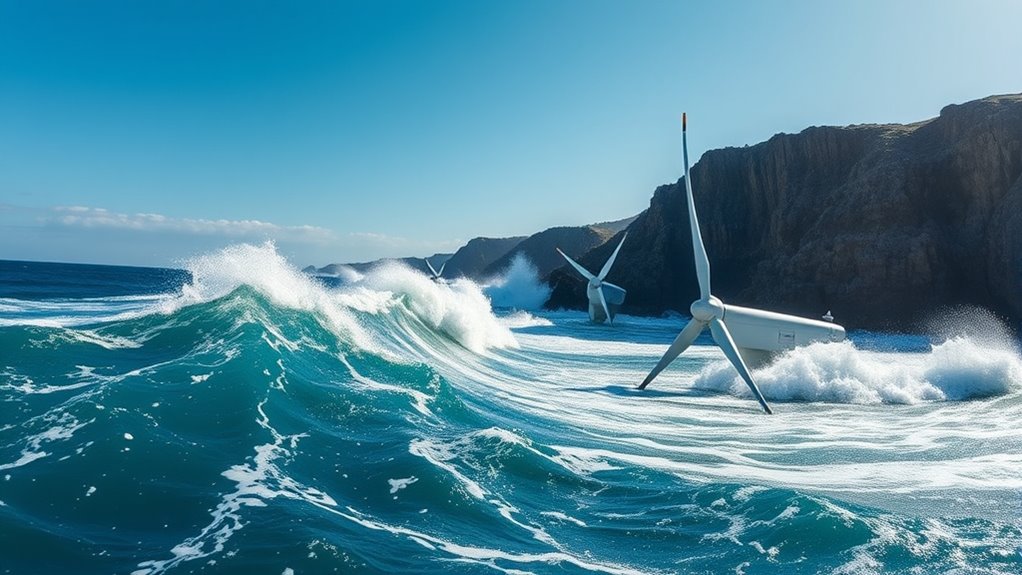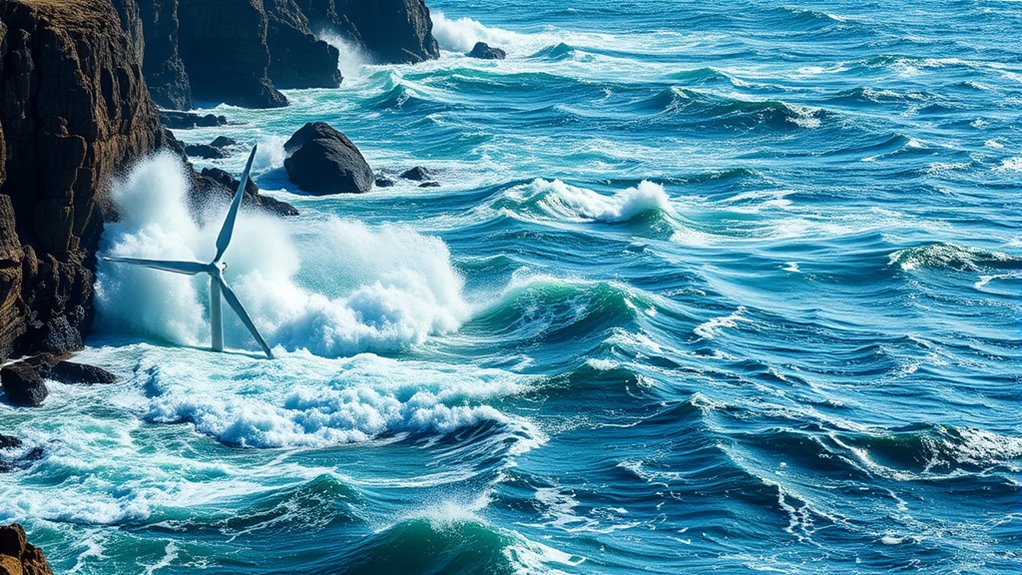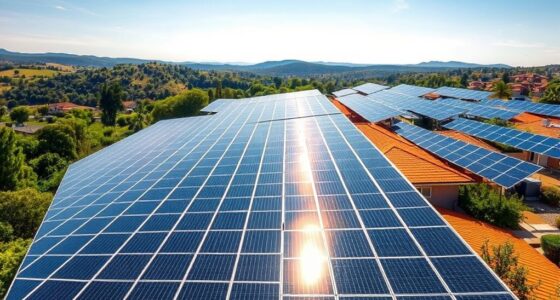Ocean energy, especially tidal and wave power, offers a reliable and clean source of renewable electricity since it harnesses the predictable movement of tides and surface waves. Tidal turbines work like underwater wind turbines, while wave devices use floating buoys or pressure systems to generate power. As technology advances and costs decrease, ocean energy could supply a significant share of future energy needs. Keep exploring to discover how this promising industry could transform the way we power our world.
Key Takeaways
- Tidal and wave power harness renewable energy from predictable ocean movements, offering a consistent and environmentally friendly energy source.
- Tidal turbines generate electricity by converting the kinetic energy of moving tides on the seabed.
- Wave technology captures surface wave energy using floating devices and oscillating systems to produce power.
- Ocean energy has vast potential, covering 70% of Earth’s surface, with decreasing costs and advancing technology.
- Integrating tidal and wave power can significantly contribute to the global shift towards sustainable, clean energy solutions.

Ocean energy harnesses the immense power of waves, tides, and currents to generate clean, renewable electricity. If you’re exploring sustainable energy sources, you’ll find that tidal turbines and wave technology are at the forefront of this effort. Tidal turbines work much like underwater wind turbines, positioned on the seabed where they spin as tides flow in and out. These turbines capture the kinetic energy of moving water, converting it into electricity that can power homes and businesses. Unlike traditional energy sources, tidal power is highly predictable because tides follow a regular cycle, giving you a reliable source of renewable energy. When you consider the environmental benefits, the appeal becomes even clearer—tidal turbines produce no greenhouse gases, and their impact on marine life can be minimized with careful design. As ongoing research continues to advance ocean energy technology, the potential for widespread adoption grows. Wave technology, on the other hand, taps into the energy of surface waves generated by wind blowing across the ocean. You might imagine devices like floating buoys, oscillating water columns, or submerged pressure systems that harness this wave motion. These devices are designed to move with the waves, transforming their motion into electrical power. Wave technology has the potential to generate significant amounts of electricity along coastlines, especially where wave activity is strong and consistent. This technology can provide a sustainable energy source for coastal communities, reducing their reliance on fossil fuels. Additionally, the development of marine energy devices continues to improve efficiency and resilience against harsh ocean conditions. The integration of ocean energy into existing power grids is also becoming more feasible, which could accelerate adoption and make these systems more accessible. What makes this even more attractive is that wave power can be integrated into existing coastal infrastructure, making it easier for you to develop and deploy. Both tidal turbines and wave technology are advancing rapidly. Engineers are constantly refining their designs to improve efficiency and durability. For you, this means that ocean energy could soon become a more affordable and widespread part of the renewable energy mix. As technology improves, the costs associated with installing and maintaining these systems are decreasing, making ocean energy a viable option for many regions. Additionally, because ocean energy is so abundant—covering about 70% of the Earth’s surface—you have access to a vast, largely untapped resource that could supply a significant portion of your renewable energy needs. The renewable energy sector is actively investing in these innovative solutions to accelerate their deployment and reduce costs further.
Frequently Asked Questions
What Are the Environmental Impacts of Tidal and Wave Energy Installations?
You might wonder about the environmental impacts of tidal and wave energy installations. These projects can affect marine habitats by disrupting local ecosystems and wildlife, potentially harming fish and seabirds. Pollution concerns are also relevant, as construction and maintenance may introduce pollutants into the water. However, compared to fossil fuels, these renewable sources generally have a lower environmental footprint, making them a cleaner option for energy generation.
How Cost-Effective Is Ocean Energy Compared to Other Renewable Sources?
You might think ocean energy isn’t cost-effective, but recent studies show a promising cost comparison with other renewables. Its high initial investment impacts long-term viability, yet technological advances are lowering costs. Tidal and wave power’s steady energy supply enhances investment viability, especially in coastal regions. While still developing, ocean energy could become more competitive, offering reliable, sustainable power that matches or exceeds the cost-effectiveness of solar and wind in the future.
What Technological Advancements Are Needed to Improve Ocean Energy Efficiency?
You need to focus on developing innovative turbines that can better harness tidal and wave energy, increasing efficiency and durability. Improving energy storage solutions is also vital, allowing you to store excess power for later use and stabilize supply. By investing in these technological advancements, you’ll make ocean energy more reliable and cost-effective, helping it compete with other renewables and maximizing its potential to deliver clean, sustainable power.
How Do Tidal and Wave Power Affect Marine Ecosystems?
You might wonder how tidal and wave power impact marine ecosystems. These energy sources can affect marine biodiversity and alter ecosystem dynamics by disrupting habitats or changing water flow patterns. While they offer renewable energy, you should contemplate potential consequences like noise pollution or physical barriers that can threaten marine life. Managing these impacts carefully ensures that renewable energy development supports both sustainable power generation and healthy ocean ecosystems.
What Are the Main Challenges in Deploying Ocean Energy Infrastructure Globally?
You face several challenges when deploying ocean energy infrastructure worldwide. Supply chain issues can delay project timelines and increase costs, while regulatory hurdles often slow approvals and create uncertainty. Managing differing policies and environmental standards adds complexity, making it harder to implement projects efficiently. Overcoming these obstacles requires coordinated efforts, clear policies, and resilient supply chains to harness the full potential of tidal and wave power globally.
Conclusion
You can see that ocean energy holds incredible potential; it could meet up to 10% of the world’s electricity needs by 2050. Tidal and wave power are reliable and predictable sources, unlike some renewable options. As technology advances, harnessing these energies becomes more feasible and cost-effective. Embracing ocean energy could profoundly reduce carbon emissions and create sustainable jobs. With such promising prospects, investing in tidal and wave power is a smart move for a greener future.










